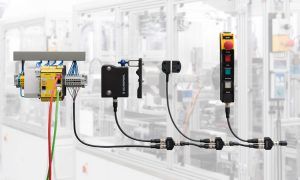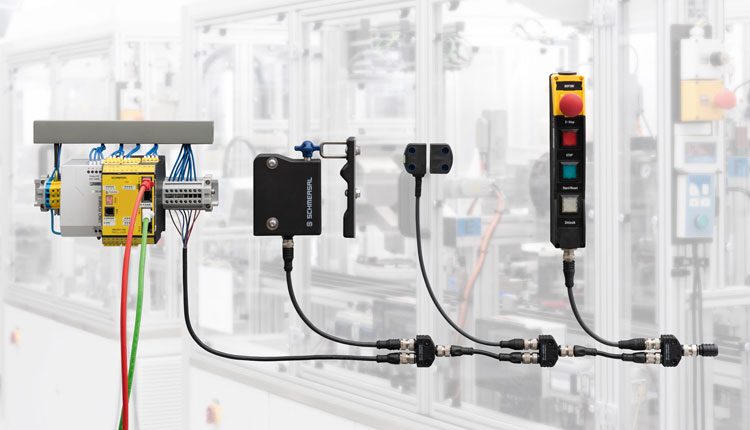Concepts for communication and signal evaluation
Machine safety in intralogistics – best when networked
When it comes to machine safety in conveyor and storage technology systems, it’s vital that the topic of ‘networking’ is on the agenda, owing to the extensive nature of the systems, and the numerous and different safety switchgear devices that they contain. With a sophisticated networking concept, you can achieve multiple goals in one go – transparency in communication, ‘lean’ wiring and intelligent linking of different system areas. Here, system engineers can choose from a number of different options.

Looking for sophisticated concepts
So what does this mean when it comes to ‘designing’ machine safety for conveying and storage systems? Irrespective of the specific and individual requirements, there should be a sophisticated concept in place for each and every hazard point that ensures the best possible integration into workplace workflows. This will create the prerequisite for high productivity and minimise any incentive there might be to tamper with the protective device (a frequent cause of occupational accidents).
Optoelectronics or guards?
This kind of concept also includes a clear view of the process and indication of the operating states of safety switchgear devices. As guards often complicate workflows (e.g. when packages are moved into and out of the danger area), the use of optoelectronics may be more suitable. This also applies to area protection around packaging machines, for example.
The trend: networking instead of individual wiring As intralogistics often involves larger systems with numerous danger areas and corresponding protection needs, it is one sector in which the networking of safety switchgear devices has been fairly well established from the outset. This has meant the replacement of traditional individual wiring of each switchgear device with efficient, network-like wiring concepts. There is a range of options available here, one of which is the AS-Interface Safety at Work (AS- i SaW) safety bus.

AS-i SaW: minimal wiring effort
The AS-i-Safety standard not only facilitates rapid installation with minimal wiring effort – it often saves on several hundred metres of wire for a single application – it also offers maximum flexibility, e.g. in the event of system modifications or new requirements and safety requirements.
Another advantage is the comprehensive range of diagnostics functions. These make for more rapid identification of the source of error in the event of irregularities or faults. This is particularly beneficial in the case of extensive, complex systems, and can help to reduce downtimes significantly. For these reasons, many intralogistics systems that Schmersal equips with safety systems are networked using AS-i SaW. This networking is also made easier because of the number of series of safety switchgear device (including optoelectronics and operating units) that are available as ‘AS versions’, i.e. with integral AS-i SaW interface.
Alternative – the Safety Fieldbox
The ‘Safety Fieldbox’ system can also be used as an alternative to the AS-Interface Safety at Work. A Safety Fieldbox enables field connection of up to eight safety switchgear devices of different types. Here, safety switchgear devices only occupy a single device connection in each case, irrespective of whether it’s a sensor or interlock. Both the safety-related and the operational signals are captured and connected to higher-level control modules via the PROFINET/PROFIsafe protocol.
The flexibility of the system will be further enhanced in the future, with the user having a choice of versions with connection to EtherNet/IP CIP Safety and EtherCAT FSoE.

Two solutions, common objectives
Both solution concepts feature straightforward installation and commissioning. What’s more, both alternatives offer potential for cost savings thanks to extensive diagnostics data and straightforward installation and wiring. Additionally, both solutions offer extreme flexibility when it comes to adapting the individual safety requirements of complex systems and machinery. Moreover, additional transmission of all diagnostics signals from connected devices ensures optimum process transparency. Plus, increasingly important as an argument is the saving that bus systems can achieve on resources like plastic and copper.
Capture and evaluate operational signals via SD 4.0
If a user only wishes to capture and evaluate operational, i.e. non-safety-related signals, the SD System solution offers a third way. This system allows electronic safety sensors and solenoid interlocks to transmit comprehensive status and diagnostic data to a higher-level machine controller.
A new feature of the SD bus is the significantly expanded networking option to include higher levels. A prerequisite for this is the connection to OPC UA as a standardised protocol for M2M communication, which has the advantage of better visualisation of diagnostic information collected in the field, and better access via mobile devices such as tablets and smartphones. This helps to facilitate predictive maintenance and additional concepts as part of Industry 4.0.
Outlook – alternative wiring concepts are coming
The examples and the three bus systems make one thing clear – alternatives to traditional wiring in safety circuits are of particular use in intralogistics systems. There are established concepts from which to choose, and the appropriate end devices to pair with them. It is only logical that alternative wiring concepts are undergoing further development. New versions of the Safety Fieldbox are conceivable, for example, perhaps with additional functions and in combination with switchgear devices. Plus, doing away with hardwired communication in its entirety in favour of wireless safety system would introduce benefits in terms of installation effort and flexibility, particularly in intralogistics.

Visit website : www.schmersal.in



